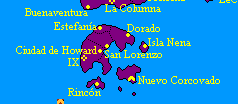Islas de la Libertad

|
This article or section is a work in progress. The information below may be incomplete, outdated, or subject to change. |
| Region of the Islas de la Libertad Région des Iles de la Liberté Región de las Islas de la Libertad | |||
| Region of | |||
| |||
| Motto | |||
| Anthem | |||
| Subdivision | Region | ||
| Capital | Nuevo Corcovado | ||
| Largest cities | Nuevo Corcovado | ||
| Area | |||
| - Ranked | |||
| Population | |||
| - Ranked | |||
| Viceroy | Governor | ||
| First Minister | |||
| Legislature | |||
| Established | 1691 AN | ||
| Languages | |||
| Local religion | |||
| Abreviation | |||
| Time Zone | |||
History
Governance
Governor
Article III, Section 1 of the Local Government Act, 1694 provided that, "Every Region as defined by the Proclamation of Punta Santiago, or admitted thereafter into the Federation, shall, after their election in accordance with this Act, thereafter be administered by a Governor, who shall be elected at large by the voters of that Region, and shall serve for a 6-year term. The Governor must be at least 25 years of age, able to read and write, of sound mind, and must be a registered voter of the Region where they intend to run for office."
The Regional and Local Government Organization Act, 1699 repealed Local Government Act, 1694 and Article 7, Section 3 provided that, "Every Region as defined by the Proclamation of Punta Santiago, or admitted thereafter into the Federation, shall, after their election in accordance with this Act, thereafter be administered by a Governor, who shall be elected at large by the voters of that Region, and shall serve for a 5-year term."
Legislature
Article III, Section 3 of the Local Government Act, 1694 established a unicameral legislature, known locally as the Cortes de las Islas de la Libertad. Article III, Section 4, provided that, "The regional legislature which shall be elected at large by the voters of that State shall serve for a 3-year term, and shall have a name and shall be in such form as each Region may provide."
Article XI, Section 3 of the Regional and Local Government Organization Act, 1699 authorized regional legislatures, "to create and charter Special City governments as they may require and provide for their organization", while Section 4, further authorized that regional legislatures "...may provide by general laws for the incorporation of Special Cities. Such laws shall limit their rate taxation for their purposes, and restrict their powers to borrow money and contract debts. Each Special City is granted power to levy other taxes for public purposes, subject to limitations and prohibitions provided by the Proclamation of Punta Santiago or by law."
Article XII, Section 2 of the Regional and Local Government Organization Act, 1699 further empowered regional legislatures, stating that they "...are authorized to create and charter localities below the level of states such as: municipalities, burghs, and other local communities as they may require. Regions may use different terms to refer to a “Municipality”, but the general term for this subdivision shall be generally known as a “Municipality”." Section 3 states that, "Localities shall have such structure as the Regions may require, provided that the boundaries of localities shall be established in consultation with residents of the aforesaid localities and provided that a simple majority of the residents therein assent to the aforesaid establishment of locality by plebiscite or referendum."
Article XII, Section 5 provided regional legislatures with the power of legislative review: "The regional legislatures shall have the power to review legislation adopted by legislative bodies of their localities, and may declare them invalid if found to be in conflict with the law."
Article XII, Section 6 also granted further authority: "Localities created by Regions under authority of this Act may be dissolved by regional legislatures, provided that a simple majority of the residents therein assent to the aforesaid dissolution by plebiscite or referendum."
Court
Article III, Section 2 of the Local Government Act, 1694 created a Regional Court.
Youth Assemblies and Civic Assemblies
Articles V, VII, and VII of the Local Government Act, 1694 instituted Youth Assemblies and Civic Assemblies in "Each existing city, town, and burgh, and such other localities that may be created under authority of this Act", (with subsidiary neighborhood youth and civic assemblies where the adult residents of a locality shall number more than two hundred) which were deliberative bodies composed of all individuals therein resident for at least six months and aged at least twenty-one years. These Youth and Civic Assemblies meet at least once a month to discuss community and youth issues, and adopt such resolutions as its members may see fit. Members of the Youth and Civic Assemblies may present petitions for redress of grievances at meetings of a Civic or Youth Assembly, with the right to speak governed in accordance with the rules of the respective civic or youth assembly.
Geography
Location
Climate
Administrative Divisions
The Islas de la Libertad is divided into Six states. They are named after their regional capital. Each of these states and autonomous regions are then subdivided into municipalities, named after its seat, which is usually its largest urban centre. These are:
- Nuevo Corcovado
- Rincón
- San Lorenzo
- Píaz de Howard
- Estefanía
- Dorado
| Name of State | Map | Coat of Arms | Capital | Population | Other cities |
|---|---|---|---|---|---|
| Nuevo Corcovado | Nuevo Corcovado | 810,276 | |||
| San Lorenzo | San Lorenzo | 701,119 | |||
| Píaz de Howard | Ciudad de Howard | 663,334 | |||
| Dorado | Dorado | 764,094 | Isla Nena | ||
| Estefanía | Estefanía | 625,550 | |||
| Rincón | Rincón | 633,946 |
Economy
Culture
| |||||



